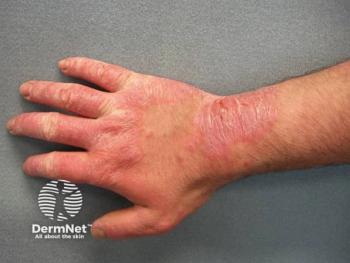
POLL: Do You Routinely Use Patch Testing When Evaluating Chronic Hand Eczema?
Click here to answer our poll.
Chronic hand eczema (CHE) represents a diagnostic and therapeutic challenge in dermatology. Characterized by persistent or relapsing inflammation of the hands lasting more than 3 months, or recurring at least twice within a 12-month period.1
However, the term often serves as a clinical umbrella, and without thorough diagnostic workup, important distinctions can be overlooked. Proper evaluation is essential to determine whether a patient truly has CHE, or whether the presentation reflects a different condition such as allergic contact dermatitis (ACD), irritant contact dermatitis, or atopic dermatitis. These disorders may present with overlapping features, but they differ in pathogenesis, prognosis, and management.2-4
Accurate diagnosis is essential, as misclassification may delay effective treatment or allow ongoing exposure to triggers. ACD, in particular, is frequently underrecognized.
Patch testing remains the gold standard for diagnosing ACD, allowing clinicians to identify hypersensitivity reactions to common allergens like nickel, fragrance mix, rubber accelerators, and preservatives. Importantly, ACD is not an eczema subtype, but a distinct immune-mediated condition that may share overlapping clinical and histologic features with other inflammatory dermatoses.2
We want to hear from our readers: When assessing a patient with a dermatoses affecting the hands, how often do you perform patch testing to evaluate for CHE or other allergic, contact, and irritant conditions?
Do you routinely use patch testing when evaluating chronic hand eczema?
References
- Ghezzi G, Falcidia C, Paolino G, et al. Chronic hand eczema (CHE): a narrative review. Dermatol Ther (Heidelb). 2025;15(4):771-795.
doi:10.1007/s13555-025-01365-7 - Tramontana M, Hansel K, Bianchi L, Sensini C, Malatesta N, Stingeni L. Advancing the understanding of allergic contact dermatitis: from pathophysiology to novel therapeutic approaches. Front Med (Lausanne). 2023;10:1184289. Published 2023 May 22.
doi:10.3389/fmed.2023.1184289 - Patel K, Nixon R. Irritant contact dermatitis - a review. Curr Dermatol Rep. 2022;11(2):41-51.
doi:10.1007/s13671-021-00351-4 - Kim J, Kim BE, Leung DYM. Pathophysiology of atopic dermatitis: Clinical implications. Allergy Asthma Proc. 2019;40(2):84-92.
doi:10.2500/aap.2019.40.4202
Newsletter
Like what you’re reading? Subscribe to Dermatology Times for weekly updates on therapies, innovations, and real-world practice tips.



















